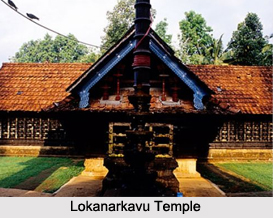 Lokanarkavu Temple is a famous temple located in the Kerala state of India. It is situated in Memunda 4 km from Vatakara, in Kozhikode District, North Malabar region of Kerala. The temple is an official shrine of the 500 Aryan Nagariks. They are said to have migrated to Kerala. The temple has a historical significance. It is said that Thacholi Othenan, legendary martial hero of Kerala, used to worship here every day. Apart from its historical significance, the temple is known for various festivals that are organized with great enthusiasm.
Lokanarkavu Temple is a famous temple located in the Kerala state of India. It is situated in Memunda 4 km from Vatakara, in Kozhikode District, North Malabar region of Kerala. The temple is an official shrine of the 500 Aryan Nagariks. They are said to have migrated to Kerala. The temple has a historical significance. It is said that Thacholi Othenan, legendary martial hero of Kerala, used to worship here every day. Apart from its historical significance, the temple is known for various festivals that are organized with great enthusiasm.
Etymology of Lokanarkavu Temple
Lokanarkavu is a short form of Lokamalayarkavu which means lokam made of mala, aaru and kavu. Here lokam means world; mala means mountain; aaru means river and kavu means grove.
Architecture of Lokanarkavu Temple
This ancient temple is believed to be about 1500 years old. It is known for its simple yet elegant architecture. It has been built in the honour of Goddess Durga. The beautiful murals and carvings here are a delight to art lovers.
Festivals of Lokanarkavu Temple
Lokanarkavu Temple organizes many festivals that are celebrated on a grand scale every year. During the festival time, the temple is decorated beautifully with lights and flowers that look very attractive. One of the most important festivals celebrated here is Pooram. It is organized in the Malayalam month Meenam (March-April). The festival is conducted with great pomp and show. It is celebrated for a week. It begins with Kodiyettam i.e. flag hoisting and concludes with Arattu.
Another important festival of the temple is Mandala Utsavam which is also known as Lokanarkavu Utsavam. This festival is celebrated in the Malayalam month Vrischikam (November-December). This is the only temple where a peculiar folk dance called Poorakkali is presented during festivals. The dance resembles the martial art Kalarippayattu.
Connectivity to Lokanarkavu Temple
Lokanarkavu Temple is well connected with all modes of transport. The closest railway station is at Vadakara, which is almost 5 km from temple. The nearest airport is Calicut International Airport which is located at a distance of 87 km away. Kerala State Road Transport Corporation and several private buses connect this temple to various places of the city.





















